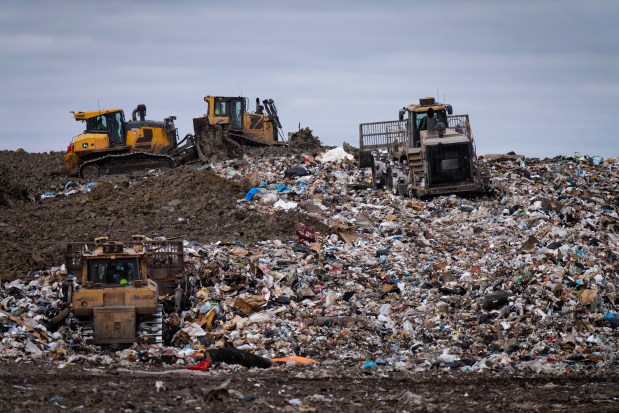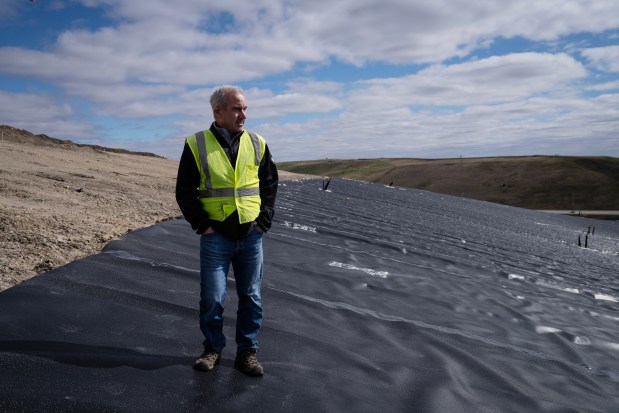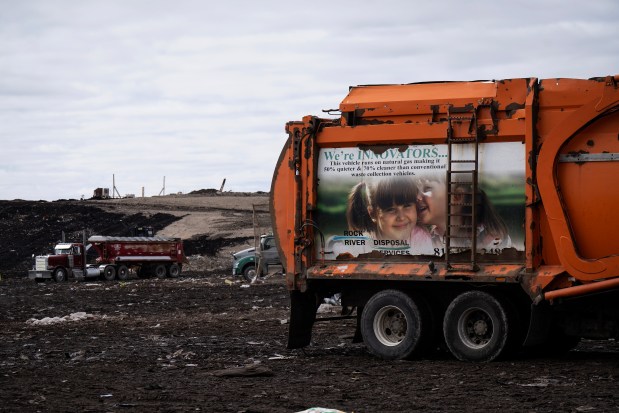The U.S. Environmental Protection Agency’s method of detecting methane leaks at landfills is flawed, and emissions of this powerful heat-trapping gas are likely much higher than what is being reported, according to a new study analyzing landfills in Illinois and seven other states.
Released Thursday by the environmental nonprofit Industrious Labs, the study is the most recent of several reports that show landfill operators are likely understating their annual emissions to the federal government as major methane leaks go unnoticed. A Harvard study using satellite data released earlier this month found emissions at landfills across the country in 2019 were 51% higher than EPA estimates for that year. A study published in March in the journal Science used airborne surveys and found emissions between 2016 and 2022 to be even higher.
“The problem is worse than the numbers show or than what we thought,” said Katherine Blauvelt, circular economy director at Industrious Labs, which seeks to reinvent heavy industry in ways that reduce emissions and protect the climate. The nonprofit’s study relied on EPA and operator data.
Illinois ranked eighth in the country with the most methane emissions from landfills in 2022, the last reporting year available, according to the study.
Odorless and colorless, methane gas is released into the atmosphere when food waste breaks down in an airtight environment without oxygen, like landfills, which are the third-largest source of human-related methane emissions in the country behind fossil fuels and agriculture.
Methane has been likened to carbon dioxide “on steroids,” so reducing its emissions is critical to slowing short-term global warming. During its first 20 years in the atmosphere, methane has more than 80 times the warming power of CO2, effectively setting the pace for worldwide temperatures in the near future.
“No one is disputing that methane coming from landfills is impacting human beings, impacting the environment, our climate,” Blauvelt said. “I think there is a lot of consensus around: We need better tools and better ways to capture that methane, to find that methane. And the tools and standards that landfill operators are following today are not setting them up for success.”
The study found “disturbing” inconsistencies nationwide among 29 landfills, where operators documented few to no methane leaks, and federal inspectors later discovered several. During inspections at several Illinois landfills, the EPA found anywhere from 20 to 60 notable methane leaks at different facilities.
Methane leaks are considered a significant source of pollution when they exceed the EPA’s methane concentration limit of 500 parts per million.
There are 96 landfills in Illinois; 54 of them are required to report annual estimates to the federal government because of how much greenhouse gases they emit. According to documents obtained from the EPA and its state counterpart through Freedom of Information Act requests, these were some of the discrepancies found between 2021 and 2023:
- In a quarterly report, the Winnebago County Landfill in Rockford reported five leaks. The EPA inspection of the same section of the landfill a month later found 59 leaks that exceeded 500 ppm.
- At Prairie Hill Landfill in Morrison, a well technician who was present during an EPA visit said the facility’s quarterly monitoring had found few to no exceedances, but federal inspectors found 51.
- In Grayslake, the Countryside Landfill operator told the EPA during an interview that an average of two to three hits of exceedances are found per year during routine monitoring. During the inspection, the EPA found 33 exceedances.
- At the LandComp Landfill in Ottawa, the operator told federal inspectors a few years had passed since they detected exceedances. During that inspection, the EPA found 23 exceedances on the site.
- A contractor reported zero leaks in the last four quarterly inspections at the Roxana Landfill in Edwardsville, while the EPA identified 42 exceedances.
Neighbors of the Winnebago landfill have complained about the odors for years. Since the issue first arose in 2019, more than 530 residents have sued the company that operates the facility, Waste Connections, and many of them hope their concerns about the stench can launch a larger discussion about landfill management.
“If we could solve the methane thing, we would go a long way towards dealing with greenhouse gases,” said Brad Roos, president of Sustain Rockford, a nonprofit helping Winnebago County develop a sustainability plan. “And because their potency is so high, it would have a great impact. You know, it may be a smaller percentage than the overall carbon dioxide greenhouse gas emissions, but it’s powerful … Let’s deal with it.”
Waste Connections, which operates the Winnebago landfill, Waste Management, which operates the Prairie Hill and Countryside landfills, and Republic Services, the company that owns the Roxana and LandComp landfills and over two dozen other facilities across Illinois, disagreed with the EPA findings.
“The monitoring of emissions from landfills sparks considerable debate and has been the source of misconceptions,” according to a statement from Republic Services. “Landfill emissions vary throughout the day due to factors like weather, composition, and age of waste. Current measurement and reporting techniques do not take these dynamic factors into account but are critical to ensure a representative assessment of landfill emissions.”
Inconsistent monitoring for leaks was only one of the shortcomings identified in the study. The material used to cover landfills, when gas collection systems are installed, and which landfills are required to install these collection systems also contribute to underreported emissions, the study says.
“I think what we’re saying is that the system isn’t working very well. It’s not that it’s not working at all,” said John Coequyt, director of U.S. government affairs at the Rocky Mountain Institute, a sustainability nonprofit. “It’s just that there’s a mismatch, sometimes, between what the operators find and what inspections or flyovers or satellites find.”
Landfills emit methane equivalent to 287 million metric tons of carbon dioxide per year, which is the same as 74 coal-fired power plants or more than 68 million gasoline-powered cars on the road for a year.
“This is becoming a five-alarm fire for the climate, for communities,” Blauvelt said.
Gaps in monitoring
On a weekday afternoon in March, Mark Furman walked on a green hill in the Winnebago landfill. Hidden under the grass were layers upon layers of trash; the inconspicuous knoll sits atop an expansion unit that operated from the 1990s until 2009. Even after being sealed, inactive units can still release methane.
Furman held a pipe outfitted with a GPS unit and a probe at its end, hovering the patent-pending device a few inches above the ground. He was monitoring the closed unit for methane emissions as part of the landfill’s quarterly inspection, which he said could take him up to two hours. If leaks are found, the landfill is expected to fix them.
Operators in the industry contend the EPA catches more leaks during its inspection than they do for their quarterly reports because of differences in testing procedures, such as the distance at which the probe is held from the cover.
During the June 2021 site inspection at the Winnebago site, the EPA recorded 59 exceedances “distinctly above historic rates,” some of which were “at locations that were supposed to have been recently corrected,” according to the EPA report.
“The EPA map is like a Christmas tree of red dots of exceedances,” Blauvelt said, looking at satellite images in the appendix of the federal report from that inspection.
According to Kurt Shaner, vice president of engineering and sustainability at Waste Connections, surface emissions at the Winnebago landfill are scanned by someone like Furman who walks across the site with a probe, its nozzle 10 cm above the ground.
“We’re at issue with how the U.S. EPA did some of their surface scans when they came to our sites,” he said. “They were going up to gas wells and sticking it down on the side of the well … down in the cracks along the ground. So we have a difference of opinion with exactly how that test was done and is being done.”
An EPA spokesperson said the agency cannot comment on the specifics of the inspection.
“The landfill regulations contain standards of how surface emission monitoring must be performed,” its statement read. “These regulations require that the monitoring probe be held 5 to 10 centimeters from the surface of the landfill. EPA inspectors follow this methodology when performing surface emission monitoring inspections at landfills.”
Blauvelt said leaks might be missed and go unreported if a landfill operator walks the property in a 100-foot grid pattern — the length of a basketball court.
“They’re not monitoring every inch. We can’t do this needle-in-a-haystack approach,” she said, where a single person is tasked to find small cracks on the cover, animal burrows or gaskets that have come loose. “Those things are hard to see across a landfill that’s acres and acres and acres.”
‘An easy fix’
A gurgling sound punctuated bird songs as bubbles fizzed from a hole half-covered with dried grass on the ground. In the video, filmed by federal inspectors at the Prairie Hill Landfill in Morrison in August 2021, a monitoring device showed a methane exceedance of over 2% — 20,000 parts per million, or 2 out of every 100 air molecules, were methane. The gas is flammable when its presence in the air reaches 5.3%.
“If it’s over 500 parts per million, that’s an exceedance,” Blauvelt said. “And if it goes into percentages, then you know it’s really bad — you’re way past parts per million.”
“There is a great deal of context involved in those matters, and thus WM is not inclined to provide detailed comments beyond the fact that those inspections took place several years ago just as new regulations were coming into effect,” Waste Management said in a statement.

“Consequently, a lack of complete alignment or agreement with respect to the findings at the time would not be unexpected or unwarranted. Regardless, WM undertook timely and appropriate corrective actions to resolve the identified concerns,” the company said.
Every day, landfills release methane into the atmosphere. In some cases, these emissions leak from cracks or erosion in the soil cover. Regulations include minimal requirements about the maintenance, repair and monitoring of landfill cover, according to experts.
The lack of gas collection and control systems or flaws in the equipment can also allow methane to escape. These systems include extraction wells to capture landfill gas — mostly methane and carbon dioxide — as bacteria break down waste. Pipes then transport the gas to dispose of it through combustion with a flare or to transform it into energy.
But only landfills of a certain size are required to install a collection and control system, a threshold advocates say is too high. Current standards also allow large landfills five years before they have to install a collection system in a unit actively receiving waste.
Yet half of the carbon in food waste degrades into methane in 3.6 years, which means a lot of methane likely escapes the landfill before it can be captured — the EPA estimates that number is 61%.
“What an easy fix: Let’s update and just ensure that that gas collection happens in time,” Blauvelt said. “None of that is rocket science. It’s doable … You solve the problem by putting the pipes in the ground before the food waste decays and actually finding the methane leaks as they happen.”
Because there’s no technology to actually measure total annual emissions, the federal government requires landfills to use a model to estimate what they’re releasing into the atmosphere.
“When companies do their inventory to report to the Greenhouse Gas Reporting (federal program), they don’t actually measure emissions at all. They just do an estimate of what’s going in the landfill,” said Coequyt, of the Rocky Mountain Institute. “So what they’re reporting is just some modeled emission potential from the landfill. And what we’re finding in these reports is that that model isn’t very accurate, and it misses a lot of operational issues.”
The Winnebago landfill, the biggest landfill methane emitter in Illinois, reported to the federal government that its methane emissions in 2022 were equivalent to 229,513 metric tons of carbon dioxide. Using a different methodology, which Shaner said offers a “more accurate representation” of their emissions, the landfill operators estimated the facility generated a methane equivalent to 131,775 metric tons of carbon dioxide in 2022. Both methods are based on models.
The EPA acknowledged its model needed improvement and last month revised the methodology to account for operational differences across facilities. In landfills, these variations can include how much downtime occurs when gas collection systems need to be fixed, the efficiency of land cover material and how much waste on the site is organic.
Advocates are pushing for the federal agency to take this updated rule further in the coming months, since estimates will still be based on models and don’t provide physical, direct measurements of what’s happening on the ground. Though estimates will be more accurate, the update still doesn’t solve the core issue of methane being released at a rate likely more alarming than is known.
By August, the EPA will review its standards and emissions guidelines under the Clean Air Act and decide whether to update them. Advocates say the agency can choose to implement sweeping regulations that require landfill operators to start using available best practices and technologies to identify and fix major sources of methane emissions and leaks.
“What we’re hoping EPA will do is establish a new standard for the operating landfills that requires the use of modern technology,” Coequyt said. “And that modern technology includes drones, but there’s other systems that could be put in place at landfills that would make a huge difference.”
Monitoring on the ground, from the air
On-the-ground technology for landfills can be small but mighty, such as an autotuning a system that automatically and continuously checks wellheads for leaks — which the EPA only requires a person do on a quarterly basis.
“We’re talking about, instead of doing an onerous system of walking on the landfill, you hire a drone operator, and then they find the leaks and you go fix them,” Coequyt said. “You maybe have to install a slightly more expensive production system. Maybe you hire a company to do the autotune on that collection system … These are not huge changes in landfill operations. This is just paying a lot more attention.”
Stronger regulations could also require operators to find and correct larger methane leaks identified by remote sensing instruments like satellites from space.
“While more work needs to be done for new monitoring technologies to be used to evaluate emissions, we remain encouraged that these technologies are improving over time,” said the statement from Republic Services.
In the meantime, some companies are implementing game-changing, near-ground technology like drones in hopes of improving their ability to detect and fix small methane leaks and large plumes.
In its statement, Waste Management said its landfills use satellite, aerial and ground measurement technologies, in some cases simultaneously, to compare data and evaluate emission measurements.

Shaner said Waste Connections is also interested in implementing such technologies on their sites, including the Winnebago landfill.
“I have heard the satellite methods are very powerful and that they can cover large areas quickly,” he said. “And I think all of them give very good concentration data.”
But, he said, drones close to the ground and satellites that are higher up often don’t account for weather data, especially wind speed, so they wouldn’t necessarily offer a complete picture of overall emissions and might be better suited to pinpoint leaks.
“It’s tough to take satellite data and convert it into mass,” Shaner said. “Satellite data is really good. We saw one satellite provider that could see a leaking gas valve in somebody’s house, to that level of detail. And you can send somebody out to fix the leak and then troubleshoot. I just don’t view it, for our application, as being a good way to measure flux, a quantity.”
To address these shortcomings of the new technological approaches, he said Waste Connections is working alongside an environmental services provider that has developed a drone outfitted with a wind meter.
“In combining the very, very location-specific wind data with concentration, you now know if the plume is right along the ground or higher in the air,” Shaner said. “It takes all the crazy math out of it … Anytime the math gets fancy, you introduce potential error.”
Advocates say ensuring effective monitoring and capture of landfill methane is a matter of prioritization and political will, and some lawmakers have joined them in urging state and federal agencies to implement stronger landfill regulations.
In early 2023, state Sen. Laura Fine, 9th District, introduced a bill to strengthen reporting methods and monitoring requirements in Illinois. It hasn’t moved forward, but her office is still working on it, according to staff. In January, U.S. Rep. Sean Casten joined 24 other members of Congress in signing a letter asking that the EPA update emissions standards for municipal solid waste landfills.
At the source
A recent analysis of 2023 EPA data by IT Asset Management Group, a company that assists in safe electronics disposal, found Illinois ranks third in the country after Michigan and Indiana for the most trash in landfills per resident, at 56.6 tons of landfill waste per capita — that’s 42.7% more than the national average. Overall, the state has over 712 million tons of waste in its landfills.
Improving and expanding municipal composting programs would reduce the amount of organic waste headed to landfills. Since more than half of landfill methane comes from food waste, addressing that would significantly reduce emissions of the powerful greenhouse gas.

In helping Winnebago County develop a sustainability plan, Sustain Rockford is starting with what Roos, its president, also calls “low-hanging fruit” — the easiest, quickest wins that can generate public interest.
One of these solutions is food waste reduction, which can be done by composting food scraps, at home in a yard or at processing centers in oxygen-rich environments. The final product can be used as a rich soil amendment to improve soil health with its mineral nutrients and beneficial microorganisms.
Besides becoming the first line of defense against greenhouse gases, reducing food waste can also alleviate stress on a landfill’s lifespan. For instance, at its current growth rate, the Winnebago County Landfill’s east expansion unit — which opened in 2019 and is being developed to up to 225 acres — will be able to accept waste for only 10 to 15 more years.
“Take my garbage, keep my taxes low, keep my streets plowed and stay out of my way — that’s the average citizen’s approach,” Roos said. “But are they aware that the landfill has a projected lifespan of another 16 years? Almost no one knows that … People have busy lives, but if you’re going to have the luxury of living that life, you’re going to have to learn what that involves.”
Like other landfill operators, Shaner said, Waste Connections is open to exploring new ways to divert waste from entering the Winnebago County Landfill.
“That decision is really made by society in general, right? If society wants to put in anaerobic digester (for) food waste, we’ll do that,” he said. “We kind of do what people want us to do with their garbage … We’re not a popular industry. Nobody likes the landfill guy, but everybody wants their trash picked up.”
Advocates hope for a cultural shift that includes better habits as well as demands for improved, more sustainable waste management.
“It’s not as simple as, ‘My takeout food from last night that I put in the trash just goes away.’ We all live with the consequences of that food, paper and yard waste,” Blauvelt said. “At the end of the day, this is about people. We all deserve healthy and clean places to live and work and play.”





